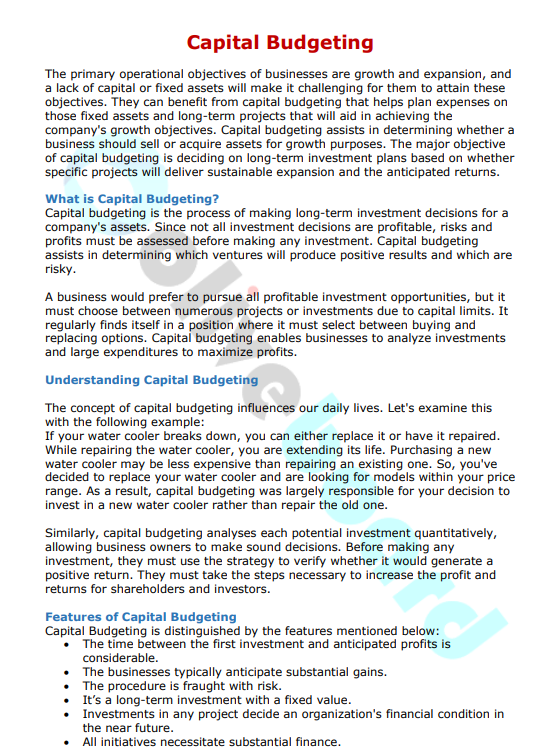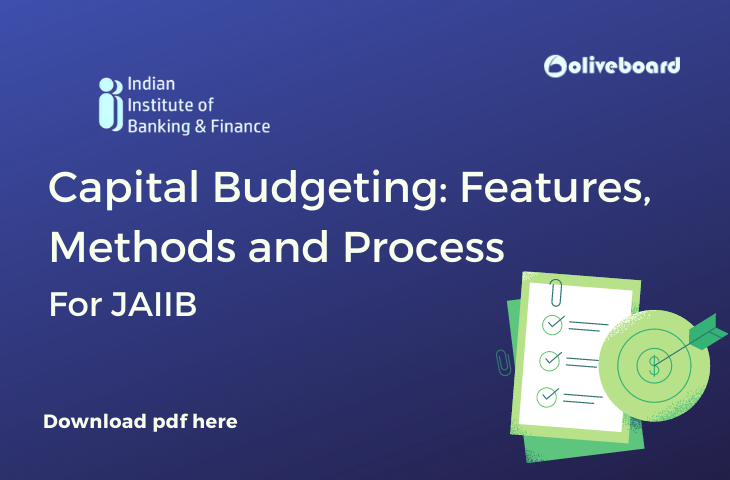Last updated on June 2nd, 2022 at 06:42 pm
The primary operational objectives of businesses are growth and expansion, and a lack of capital or fixed assets will make it challenging for them to attain these objectives. They can benefit from capital budgeting that helps plan expenses on those fixed assets and long-term projects that will aid in achieving the company’s growth objectives. Capital budgeting assists in determining whether a business should sell or acquire assets for growth purposes. The major objective of capital budgeting is deciding on long-term investment plans based on whether specific projects will deliver sustainable expansion and the anticipated returns. For JAIIB candidates, understanding Capital Budgeting is extremely important. There are two JAIIB exams each year. Capital Budgeting: Features, Methods and Process will be discussed in this blog.
Download the Capital Budgeting: Features, Methods and Process Free E-book
How to Download Capital Budgeting: Features, Methods and Process E-book for JAIIB?
Step 1: Click on the download link. You will be redirected to Oliveboard’s FREE E-Books Page.

Step 2: Create a free Oliveboard account or login using your existing Oliveboard account details
Step 3: Download the book by clicking on the link presented on the page.
Introduction
The primary operational objectives of businesses are growth and expansion, and a lack of capital or fixed assets will make it challenging for them to attain these objectives. They can benefit from capital budgeting that helps plan expenses on those fixed assets and long-term projects that will aid in achieving the company’s growth objectives. Capital budgeting assists in determining whether a business should sell or acquire assets for growth purposes. The major objective of capital budgeting is deciding on long-term investment plans based on whether specific projects will deliver sustainable expansion and the anticipated returns.
What is Capital Budgeting?
Capital budgeting is the process of making long-term investment decisions for a company’s assets. Since not all investment decisions are profitable, risks and profits must be assessed before making any investment. Capital budgeting assists in determining which ventures will produce positive results and which are risky.
A business would prefer to pursue all profitable investment opportunities, but it must choose between numerous projects or investments due to capital limits. It regularly finds itself in a position where it must select between buying and replacing options. Capital budgeting enables businesses to analyse investments and large expenditures to maximise profits.
Understanding Capital Budgeting
The concept of capital budgeting influences our daily lives. Let’s examine this with the following example:
If your water cooler breaks down, you can either replace it or have it repaired. While repairing the water cooler, you are extending its life. Purchasing a new water cooler may be less expensive than repairing an existing one. So, you’ve decided to replace your water cooler and are looking for models within your price range. As a result, capital budgeting was largely responsible for your decision to invest in a new water cooler rather than repair the old one.
Similarly, capital budgeting analyses each potential investment quantitatively, allowing business owners to make sound decisions. Before making any investment, they must use the strategy to verify whether it would generate a positive return. They must take the steps necessary to increase the profit and returns for shareholders and investors.
Features of Capital Budgeting
Capital Budgeting is distinguished by the features mentioned below:
- The time between the first investment and anticipated profits is considerable.
- The businesses typically anticipate substantial gains.
- The procedure is fraught with risk.
- It’s a long-term investment with a fixed value.
- Investments in any project decide an organisation’s financial condition in the near future.
- All initiatives necessitate substantial finance.
- A company’s profitability depends on the amount invested in any project.
Popular Methods of Capital Budgeting
When making capital budgeting decisions, a business must establish whether the project will be profitable. Although there are various capital budgeting methods, the most popular approaches for choosing profitable projects are:
- Payback Period (PB): This approach refers to the amount of time it will take for the project to generate enough cash to reimburse the initial investment. It focuses solely on cash flows, the investment made in the project, and the project’s economic life, irrespective of the time value of money.
- Internal Rate of Return (IRR): It is a discounting cash flow method that calculates a project’s return rate. The internal rate of return (IRR) is the discounting rate at which the net present value is zero, meaning the sum of the first cash outflow and discounted cash inflows equals zero.
Net Present Value (NPV): The NPV approach compares the present value of future cash flows of a project with the cash outlay necessary to finance it. It determines if the project creates a surplus by evaluating the cash flows in terms of their present value.
Take a peek at the Capital Budgeting: Features, Methods and Process Free E-book

Conclusion
Capital budgeting leads to identifying profitable capital expenditures, which aids in the decision to accept or reject a particular proposal. The Payback Period, Net Present Value Method, and Internal Rate of Return are capital budgeting approaches. The process involves stages, such as identifying new projects, analysing, selecting, and implementing projects, and then evaluating their performance for future considerations. Despite its popularity, the process has both advantages and disadvantages.
This was all about Capital Budgeting: Features, Methods and Process for JAIIB. Our goal is to provide candidates with information that will help them prepare for the JAIIB exam. Keep following Oliveboard for more updates. To stay updated, follow Oliveboard on Facebook and Telegram.
FAQs
Ans: The process of Capital Budgeting includes phases, such as finding new projects, analyzing, choosing, implementing them, and evaluating their performance for future picks.
Ans: Limitations of Capital Budgeting are:
– Cash Flows
– Time Horizon
– Time Value
– Discount Rates
JAIIB Study Material Compilation
Also Read:
- 5-Important Tips To Crack JAIIB Exams| Check Here (oliveboard.in)
- JAIIB Frequently Asked Questions- 2022| Check Here (oliveboard.in)
- JAIIB Genius | JAIIB Weekly Quiz PDF – JAIIB Questions PDF (oliveboard.in)
- JAIIB Full Form – Junior Associate of the Indian Institute of Bankers (oliveboard.in)
- JAIIB and CAIIB Books- Exams Syllabus, Books, and more (oliveboard.in)
Also Check:
- JAIIB 2022 Exam -Notification Released (oliveboard.in)
- JAIIB Notification 2022 – Notification PDF, Eligibility, (oliveboard.in)
- JAIIB Apply Online – Application Form 2022, Fees, Instru (oliveboard.in)
- JAIIB Eligibility – Age, Degree, Nationality, Members (oliveboard.in)
- JAIIB Syllabus – Complete List of Papers, Modules (oliveboard.in)
- JAIIB Exam Pattern 2022 – Details of Pattern, Marking (oliveboard.in)
- JAIIB Admit Card November 2022 – Steps and Direct Download (oliveboard.in)
- JAIIB 2022 Cut Offs – Check JAIIB Minimum Cut Off (oliveboard.in)

Hello there! I’m a dedicated Government Job aspirant turned passionate writer & content marketer. My blogs are a one-stop destination for accurate and comprehensive information on exams like Regulatory Bodies, Banking, SSC, State PSCs, and more. I’m on a mission to provide you with all the details you need, conveniently in one place. When I’m not writing and marketing, you’ll find me happily experimenting in the kitchen, cooking up delightful treats. Join me on this journey of knowledge and flavors!
